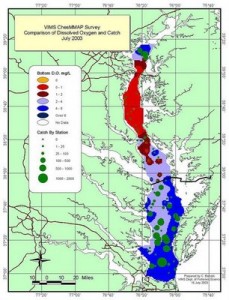
The Chesapeake: Oxygen & Fish Catch
“Poisoned Waters,” a documentary on PBS Frontline examines the state of our nation’s waterways. It focuses on the Chesapeake and the Puget Sound. As the title suggests, the nation’s waterways are far from pristine. Click here for Tim Wheeler’s review in the Baltimore Sun and here for Frontline. The documentary suggests that the Clean Water Act, in response to Earth Day, 1970, started off well. But gutting regulation, castrating the EPA, allowing open dumping and externalizing cleanup costs do not solve pollution problems. Perdue, in his denial that chicken manure contributes to algae blooms in the Chesapeake, sounds like a shill for the tobacco industry saying “Well we know the plaintiff smoked 4 packs a day for 25 years. How do we know the cigarettes caused lung cancer? How do we know lung cancer killed him? He died when his heart stopped. The cancer was in his lungs.”
This image, from Science Daily, shows a dead zone in the northern stem of the Chesapeake. The area in red shows oxygen depletion. The area in blue shows oxygen. The green circles in the blue zone show fish catch.
On Earth Day, 2009, we have much to do. It is not as if we have accomplished nothing in the last 39 years. However, we see two glaring omissions in the clean water act. It doesn’t regulate farm waste or coal ash. We also need to understand that regulation and enforcement are effective and deregulation and voluntary compliance does not work. After all, we have police and prosecutors to chase and bring to trial criminals in order to protect the citizens. Speed limits and parking regulations are not “goals” or “guidelines” for voluntary compliance. They are hard and fast laws. Break the law; get a ticket. This paradigm must be applied to protecting the nation’s waterways.
But here’s an idea: Take this algae-manure system and transform it from one that is destroying an estuary into one that is creating the biofuels for the next generation of cars and power plants!